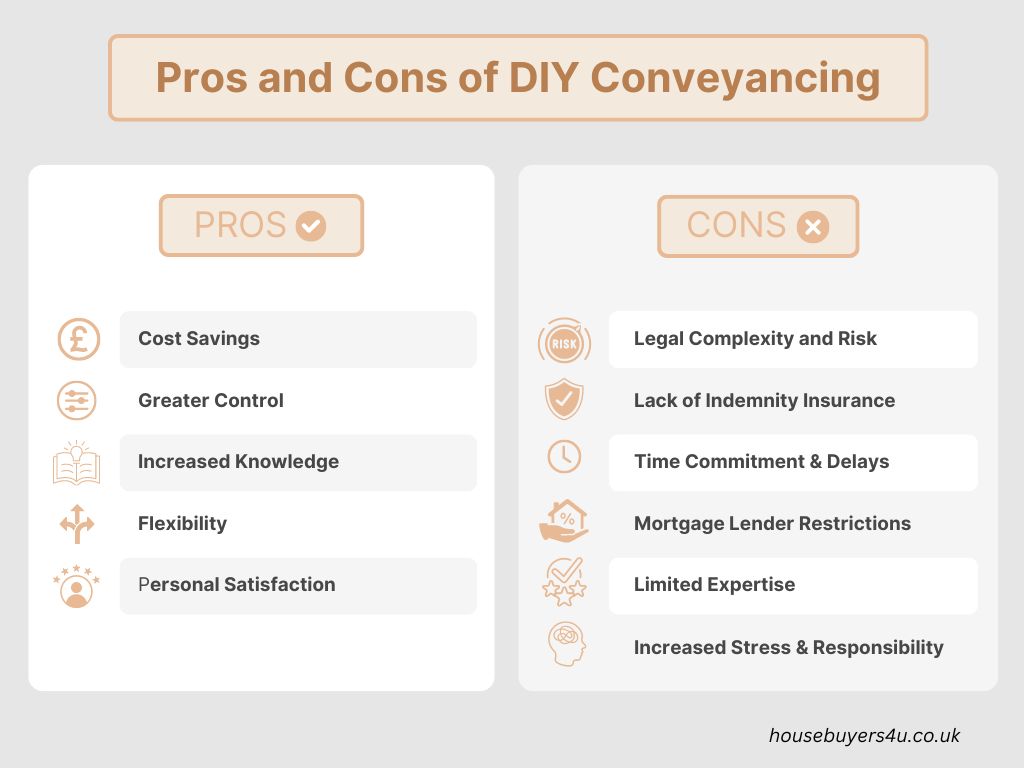DIY Conveyancing: Is it Possible & How Much Can I Save?
Thinking about taking control of your property transaction and cutting down on legal fees? Our DIY conveyancing guide is packed with practical advice and tips, including:
- DIY conveyancing could save you approximately £800 - £1,400 in direct costs compared to using a solicitor
- Insight into potential risks, along with smart strategies to dodge common pitfalls
- A step-by-step guide to managing your own conveyancing without a solicitor
-
- Can You Do Your Own Conveyancing?
- DIY Conveyancing vs Solicitors: Cost Comparison
- Pros and Cons of DIY Conveyancing
- Step-by-Step Guide to DIY Conveyancing
- Top Pitfalls to Avoid and How to Stay on Track
- When to Seek Professional Help
- Legal Responsibilities and Risks
- A Stress-Free Alternative: Housebuyers4u
- Final Thoughts and Key Takeaways
- FAQs
Can You Do Your Own Conveyancing?
Yes, handling your own conveyancing is possible if you're up for the challenge.
However, before diving in, it’s important to understand what this involves and whether it suits your situation.
Legal Requirements and Restrictions
You can do your own conveyancing, particularly with a freehold property, where you own the property and the land outright.
However, there are situations where DIY conveyancing isn't possible, such as:
-
If you're getting a mortgage
-
If the transaction is complex.
Skills and Knowledge Needed
Taking on conveyancing yourself means you’ll need to get comfortable with legal terms and property law. You’ll be dealing with contracts, searches, and other important documents that need to be done just right.
Here are the key skills you’ll need:
-
Attention to detail: Mistakes can lead to costly delays or even legal disputes.
-
Legal understanding: A good knowledge of property law and legal processes is necessary to handle the paperwork.
-
Negotiation skills: You may need to negotiate terms with the other party or their conveyancing solicitor, which requires confidence and a clear understanding of your position.
Time Commitment Involved
DIY conveyancing requires a significant time commitment. You’ll need to dedicate time to researching the process and understanding your transaction's specific requirements.
Additionally, expect to spend time filling out various forms and submitting them to the appropriate bodies like the HM Land Registry.
DIY Conveyancing vs Solicitors: Cost Comparison
When considering whether to handle your own conveyancing or hire a solicitor, one of the key factors is often the potential cost savings. While DIY conveyancing can indeed save you money, it's important to understand the full picture of costs involved in both approaches. Let's break down the typical costs associated with DIY conveyancing versus using a solicitor.
| Cost Item | DIY Conveyancing | Solicitor |
|---|---|---|
| Legal Fees | £0 | £850 - £1,500 |
| Search Fees | £200 - £300 | £200 - £300 |
| Land Registry Fees | £20 - £910 | £20 - £910 |
| Stamp Duty | Varies (same for both) | Varies (same for both) |
| Bank Transfer Fee | £25 - £50 | £25 - £50 |
| Land Registry Search | £3 | £3 |
| Bankruptcy Search (per name) | £2 | £2 |
| DIY Conveyancing Kit (optional) | £50 - £100 | N/A |
| Professional Indemnity Insurance | Not typically available | Included in legal fees |
| Time Cost | Significant personal time investment | Minimal personal time required |
Cost Breakdown and Analysis
- Legal Fees: This is where the most significant difference lies. With DIY conveyancing, you're saving the entire legal fee that a solicitor would charge. However, it's important to consider the value of your time and the potential risks of mistakes.
- Search Fees: These costs are similar whether you do it yourself or use a solicitor. However, solicitors may have established relationships with search providers, potentially leading to faster turnaround times.
- Land Registry Fees: These are fixed costs set by the government and will be the same regardless of whether you use a solicitor or not.
- Stamp Duty: This tax is based on the property value and will be the same whether you handle the conveyancing yourself or use a solicitor.
- Bank Transfer Fee: This cost for transferring the funds to purchase the property is typically similar in both cases.
- Land Registry and Bankruptcy Searches: These are fixed, nominal fees that are the same in both scenarios.
- DIY Conveyancing Kit: If you choose to purchase a kit to guide you through the process, this is an additional cost for DIY conveyancing. However, it's often much less than solicitor fees.
- Professional Indemnity Insurance: This is a crucial difference. Solicitors are required to have this insurance, which protects you if they make a mistake. As a DIY conveyancer, you typically can't obtain this insurance, which increases your personal risk.
- Time Cost: While not a direct monetary cost, the time you spend on DIY conveyancing is significant. If you're taking time off work or sacrificing other activities, there's an opportunity cost to consider.
In total, DIY conveyancing could save you approximately £800 - £1,400 in direct costs compared to using a solicitor. However, this doesn't account for the value of your time or the potential costs of any mistakes made during the process.
It's also worth noting that some mortgage lenders require a solicitor to be involved in the process, which could limit your ability to choose DIY conveyancing.
While the potential savings from DIY conveyancing are significant, it's crucial to weigh these against the time commitment required and the increased personal risk. For those with the time, confidence, and attention to detail necessary to handle the complex legal process, DIY conveyancing can be a cost-effective option. However, for many, the peace of mind and professional expertise provided by a solicitor may be worth the additional cost.
The Pros and Cons of DIY Conveyancing
When considering whether to handle your own conveyancing, it's crucial to weigh the advantages against the potential drawbacks. Here's a comprehensive look at both sides:
Pros
- Cost Savings:
- Eliminating solicitor fees can significantly reduce overall transaction costs.
- Potential savings of £500 to £1500 or more, depending on the property value.
- Greater Control:
- Personal management of each step in the process.
- Ability to set your own pace and priorities.
- Direct communication with all parties involved.
- Increased Knowledge:
- Gain valuable insights into property law and the conveyancing process.
- Better understanding of your property's legal status and history.
- Flexibility:
- Work on your conveyancing outside of traditional office hours.
- Avoid delays caused by solicitor workloads or holidays.
- Personal Satisfaction:
- Sense of accomplishment from handling a complex legal process.
- Confidence boost for future property transactions.
Cons
- Legal Complexity and Risk of Errors:
- Conveyancing involves complex legal processes and terminology.
- Misunderstanding or overlooking crucial legal details can lead to serious complications.
- Errors in searches, contract details, or land registry applications can have long-lasting consequences.
- Lack of Professional Indemnity Insurance:
- Solicitors are required to have professional indemnity insurance, which protects clients from financial losses due to errors.
- As a DIY conveyancer, you have no such protection.
- Any mistakes could lead to significant personal financial liability.
- Time Commitment and Potential Delays:
- The conveyancing process is time-consuming and can be overwhelming for newcomers.
- Learning the procedures, completing paperwork, and conducting searches can take considerable time.
- Inexperience can lead to delays, potentially jeopardising the entire transaction.
- Mortgage Lender Restrictions:
- Many mortgage lenders require a professional solicitor or licensed conveyancer to handle the process.
- This requirement can completely rule out the DIY option for many buyers.
- Proceeding without meeting lender requirements could result in the mortgage offer being withdrawn.
- Limited Expertise in Complex Situations:
- Property transactions can involve unexpected complications (e.g., boundary disputes, restrictive covenants, or leasehold issues).
- Without professional experience, handling these situations can be challenging and potentially costly.
- Lack of expertise in negotiating complex legal points with the other party can put you at a disadvantage.
- Increased Stress and Responsibility:
- The entire legal responsibility of the transaction rests on your shoulders.
- This can lead to significant stress, especially if issues arise.
- The pressure of ensuring everything is done correctly can be overwhelming, particularly for first-time buyers or sellers.
Related: What is a blight notice?
When deciding whether to pursue DIY conveyancing, carefully consider these pros and cons in the context of your specific situation, property type, and comfort level with legal processes. For complex transactions or if you're unsure, it may be wise to consult with a professional conveyancer, even if only for initial guidance or final review.
Step-by-Step Guide to DIY Conveyancing
If you’re still set on handling your own conveyancing, here’s how to navigate the process, whether you’re buying or selling a house.
Steps When Buying a House
1. Pre-contract Stage
-
Conduct local authority searches to check for issues like planning permissions, road schemes, or environmental factors that might affect the property.
Form Required: LLC1 (Local Land Charges Search Request) and CON29 (Enquiries of Local Authority Form)
-
Arrange a property survey to identify any structural issues or necessary repairs. This step doesn't require a specific form but is necessary for identifying potential problems.
-
Secure a formal mortgage offer in place if you’re using one. Review the lender’s requirements carefully to avoid any issues later on.
Form Required: Mortgage offer document (provided by the lender)
2. Drafting and Exchanging Contracts
-
Prepare the draft contract and include the details of the property, agreed price, and any fixtures or fittings included in the sale.
Form Required: Standard contract template (often provided by conveyancing kits or can be drafted with guidance)
-
Thoroughly review the contract and check if all details are correct. Pay special attention to any conditions attached by the seller.
-
Once both parties agree, contracts are exchanged, and you typically pay a deposit at this stage. This step legally binds both parties to the transaction.
Form Required: Exchange of contracts document
3. Pre-completion Steps
-
Conduct final property searches to confirm no changes have occurred since the initial searches.
Form Required: OS1 (Official Search of Whole with Priority) to protect your interest in the property until registration
-
Prepare the transfer deed, which the seller will sign to officially transfer ownership of the property to you.
Form Required: TR1 (Transfer of Whole of Registered Title)
-
Finalise mortgage arrangements with your lender and check if funds are available for completion.
Form Required: Completion statement (from your lender)
4. Completion and Post-completion Tasks
-
On completion day, the remaining funds are transferred, and you receive the keys to your new home. The property becomes officially yours.
Form Required: DS1 (Discharge of Mortgage) if applicable, to show the mortgage has been paid off
-
Pay any required Stamp Duty Land Tax within 14 days of completion.
Form Required: SDLT1 (Stamp Duty Land Tax Return)
-
Register your ownership with HM Land Registry so the property is correctly recorded in your name.
Form Required: AP1 (Application to Change the Register).
Steps When Selling a House
1. Pre-contract Stage
-
Complete necessary property information forms to provide the buyer with all relevant details about the property.
Forms Required: TA6 (Property Information Form), TA10 (Fittings and Contents Form), and TA7 (Leasehold Information Form) if applicable.
-
Gather your title deeds or request them from your lender if the property is mortgaged.
Form Required: Official Copies of Title from the Land Registry
2. Drafting and Exchanging Contracts
-
Prepare the draft contract and specify the property details, sale price, and what’s included in the sale.
Form Required: Standard Contract Template
-
Address any queries the buyer may have about the property and provide accurate information.
-
Once all parties are satisfied, contracts are exchanged. The buyer also pays a deposit and makes the sale legally binding.
Form Required: Exchange of Contracts Document
3. Pre-completion Steps
-
Answer any final questions from the buyer’s solicitor and agree on a completion date.
-
If you have a mortgage, obtain a redemption statement to know the exact amount you need to pay off.
Form Required: Mortgage Redemption Statement (provided by your lender)
4. Completion and Post-completion Tasks
-
On the agreed completion day, you receive the balance of the sale price and hand over the keys. You will officially transfer the ownership to the buyer.
Form Required: TR1 (Transfer of Whole of Registered Title) signed by you and handed to the buyer
-
Use the funds received to pay off any outstanding mortgage balance.
Form Required: DS1 (Discharge of Mortgage) if applicable
-
Settle any remaining accounts, such as estate agent fees or outstanding bills related to the property. Be aware that you may also need to pay Capital Gains Tax on any profit you’ve made, depending on your circumstances.
Top 3 Pitfalls to Avoid and How to Stay on Track
When handling your own conveyancing, it’s easy to make mistakes that could lead to delays or additional costs. Here are some common pitfalls and tips on how to avoid them:
1) Overlooking Important Searches
Skipping or overlooking key property searches, such as local authority or environmental searches, can lead to unexpected issues after purchase.
To avoid this, conduct all necessary searches to uncover potential problems with the property or surrounding area.
2) Misunderstanding Legal Jargon
The legal language used in conveyancing documents can be confusing, and misunderstanding it can result in costly errors.
Take the time to familiarise yourself with common legal terms or consult online legal dictionaries and resources to ensure you fully understand the documents you’re handling.
3) Missing Critical Deadlines
Missing deadlines, such as those for exchange of contracts or paying Stamp Duty, can lead to financial penalties or even losing the property. Keep a detailed timeline and set reminders for all key dates to ensure you stay on track throughout the process.
When to Seek Professional Help
While DIY conveyancing can be a cost-effective option, there are times when seeking professional assistance is the wiser choice. Here’s when you should consider getting help:
Complex Property Situations
If you’re dealing with a complex property transaction, such as:
-
Buying a leasehold property
-
Dealing with boundary disputes
-
Purchasing through a shared ownership scheme
It’s advisable to consult a professional in these situations, as they involve complex legal issues that require expert knowledge.
Signs That the Process Is Becoming Too Challenging
If you find yourself struggling to:
-
Keep up with the legal jargon
-
Facing unexpected issues
-
Feeling overwhelmed by the paperwork
These might be signs that the process is becoming too challenging. When this happens, contacting a solicitor can prevent potential mistakes and help you proceed with the transaction smoothly.
Tip: If you decide to seek professional help, start by looking for solicitors or licensed conveyancers with experience in property law.
Related: How to find a good conveyancer
Legal Responsibilities and Risks
Taking on the role of a DIY conveyancer comes with significant legal responsibilities and potential risks.
As a DIY conveyancer, you are fully responsible for ensuring that all legal aspects of the property transaction are correctly handled. This includes:
-
Preparing and reviewing contracts
-
Conducting necessary searches
-
Complying with all legal requirements
In some cases, these mistakes could lead to disputes that end up in court, where you might face unexpected court fees in addition to the stress and time involved.
Insurance and Indemnity Considerations
Unlike a licensed conveyancer, a DIY conveyancer typically does not have professional indemnity insurance to cover potential mistakes.
If something goes wrong, any financial loss will come out of your pocket. It might be a good idea to get an insurance policy to cover any risks involved with DIY conveyancing but keep in mind that this will add to your overall costs.
A Stress-Free Alternative: Housebuyers4u
If you're considering DIY conveyancing but want a stress-free alternative, Housebuyers4u offers a reliable option with a 100% no fall-through guarantee.
Our cash offer is based on local market expertise and an independent valuation, ensuring a fair deal with no surprises.
As a genuine property buying company, we handle everything directly, with no middlemen or mortgages involved. Plus, you'll have a dedicated property sales adviser guiding you through every step of the sale. Read our success stories here.
Final Thoughts & Key Takeaways
DIY conveyancing can be a rewarding and cost-effective way to manage your property transaction, but it’s not without its challenges.
If you’re well-prepared, understand the legal requirements, and are willing to invest the time, it can be a cost-effective option.
However, the risks of mistakes and the complexity of the process should not be underestimated.
Key Takeaways:
-
Know the risks: DIY conveyancing requires careful attention to detail and a solid understanding of legal processes. Mistakes can be costly.
-
Consider the costs: While you can save money on professional conveyancing fees, hidden costs and the value of your time should be factored into your decision.
-
Seek help when needed: If the process becomes overwhelming or complex, don’t hesitate to consult a professional to avoid potential pitfalls.
Ultimately, whether you choose DIY conveyancing or professional services, the decision should be based on your comfort level with the legal process and the specifics of your property purchase.
Frequently Asked Questions about DIY Conveyancing



